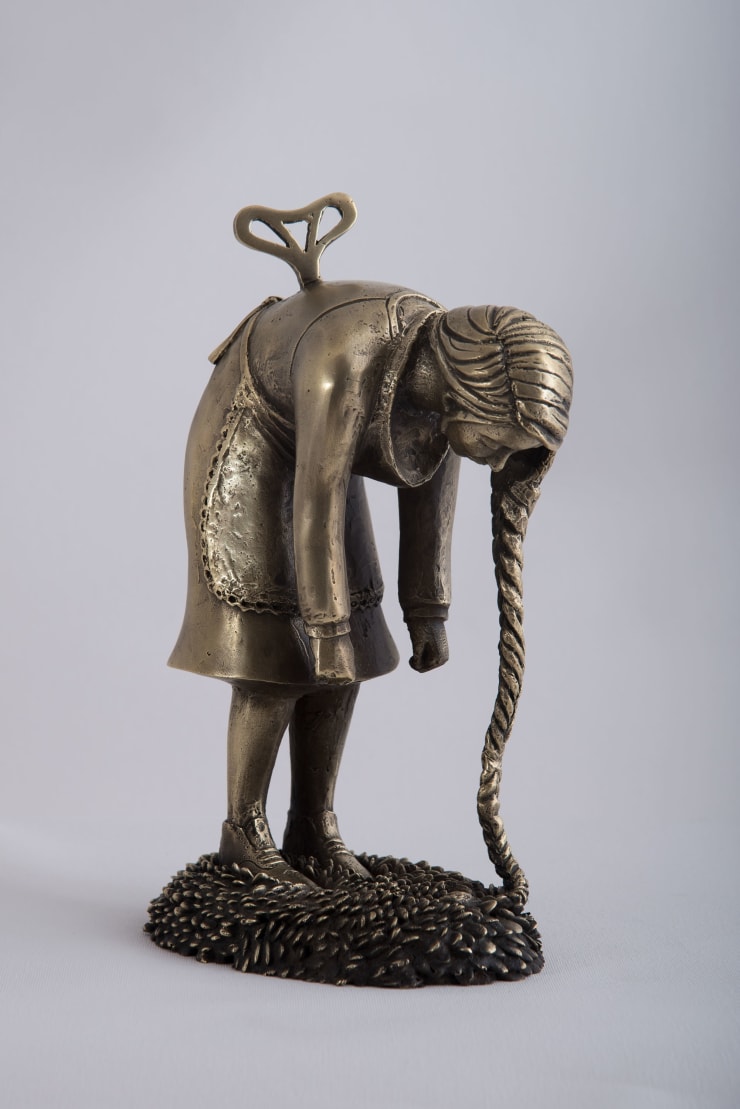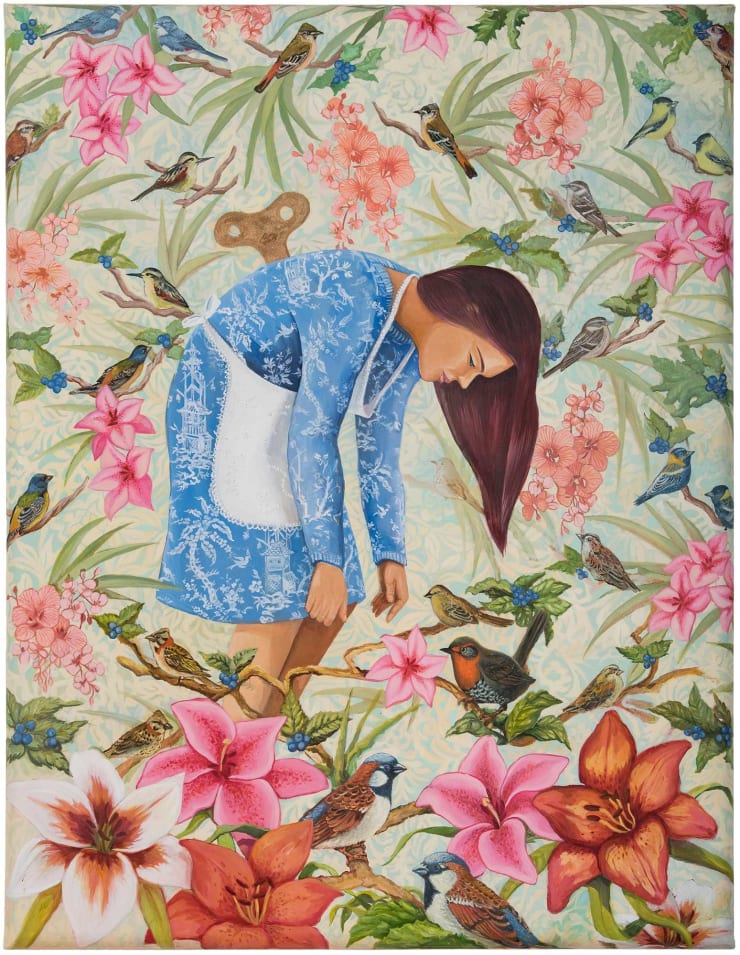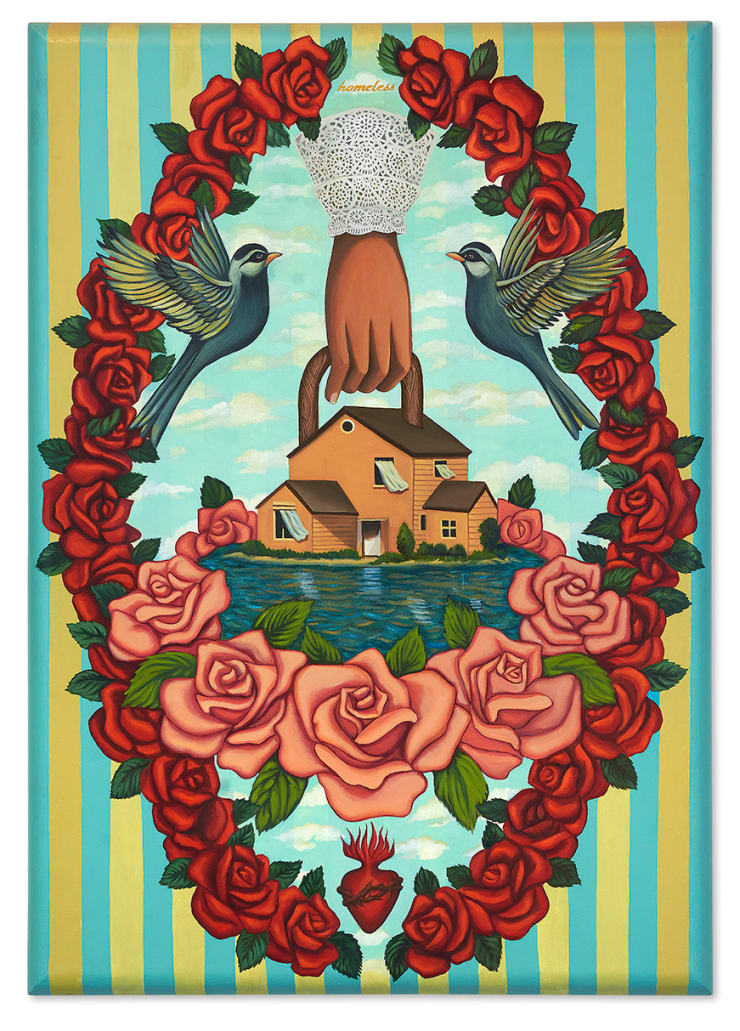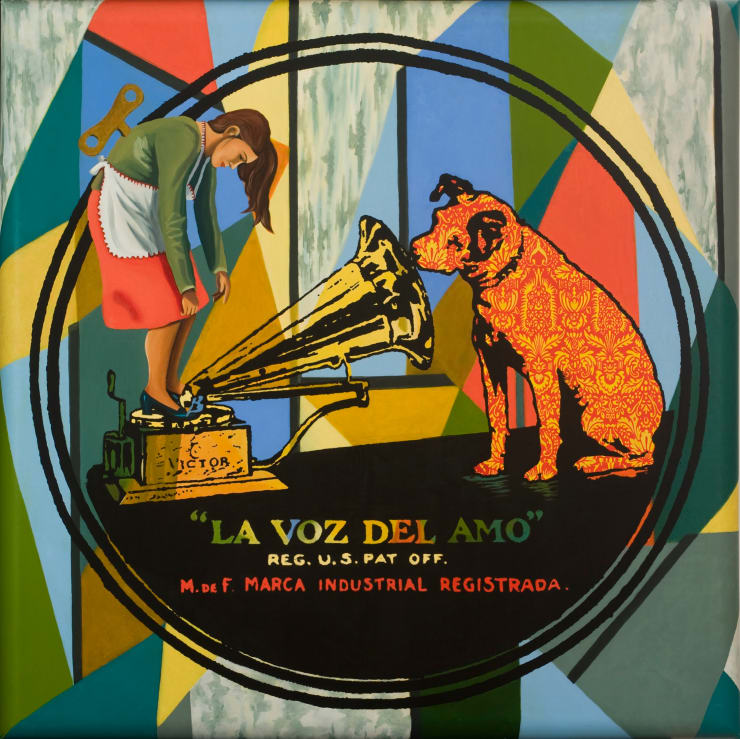Bruna Truffa Chilean, b. 1963
The question of identity, memory, and the domestic realm runs through Bruna's work. Her work is characterized by a strong female perspective, and her visual narrative incorporates elements such as Latin American mestizaje, oriental kitsch aesthetics, the everyday, religious imagery, among others.
Bruna Truffa is a visual artist with studies in art at the University of Chile and a Bachelor of Arts with a specialization in Painting from the Institute of Contemporary Art between 1980 and 1986 in Santiago, Chile. She later completed a Master's degree in Aesthetics and Art Theory with a specialization in 20th-century art at the Autonomous University of Madrid in Spain.
During the 1980s, she actively participated in the art scene in Chile, proclaiming "The Return of Painting" as a political and dissenting option in response to the extreme intellectualization of the Avanzada art scene at the time. She created art collectives and carried out street interventions on city walls, which were prohibited by the dictatorship in Chile during the 1980s.
Later, she regrouped to form a new collective with Rodrigo Cabezas and Sebastián Leyton, holding various exhibitions in Santiago. They were part of a collective submission to the Museum of Contemporary Art in Buenos Aires, where they came into contact with the new scene of Argentine painting in the 1990s. They were also invited to participate in a collective submission to Germany for the exhibition of Chileans at the Staatlichenn Kuntshalle Museum in Berlin. With this participation, the trio traveled to Europe, where Truffa-Cabezas settled in Madrid and Leyton in Paris. In Madrid, Truffa-Cabezas exhibited in various cultural centers and galleries, connecting with other collectives in the Spanish art scene such as Strujenbank, Equipo Limite, among others.
Truffa-Cabezas-Leyton returned to Chile in 1993 and held the exhibition "Natural History" at the Museum of Contemporary Art to commemorate 10 years of teamwork. They also participated in and won the V Biennial of Painting in Cuenca, Ecuador, in 1998. Subsequently, Truffa-Cabezas obtained a Fondart to carry out research and create works for the exhibition "Si vas para Chile" at the National Museum of Fine Arts (1999) and received the Critics' Award the same year.
From 2003, each of them decided to continue developing as individual artists. Truffa focused on researching identity issues and delved into gender themes, the repetition of the landscape as an identity trait, explored non-traditional techniques such as collage, embroidery, objects, and had an intimate relationship with popular art, placing it in tension and confronting it with classical painting.
Bruna has exhibited in places such as the National Museum of Fine Arts (Santiago, Chile), the Museum of Contemporary Art of São Paulo (São Paulo, Brazil), the Nahim Isaías Museum (Guayaquil, Ecuador), the Museum of Visual Arts MAVI (Santiago, Chile), the Museum of Contemporary Art MAC (Santiago, Chile), the Palace of La Moneda Museum (Santiago, Chile), Kunstwerk Carlshütte (Büdelsdorf, Germany), Staatlichen Kuntshalle (Berlin, Germany), the Museum of Contemporary Art in Valdivia (Valdivia, Chile), Galería Víctor Saavedra (Barcelona, Spain), Galería Il Ponte Contemporanea (Rome, Italy), Galería Patricia Ready (Santiago, Chile), Galería Espacio O (Santiago, Chile), Galería Animal (Santiago, Chile), among others.
The artist lives and works in Santiago de Chile.
-
 Bruna TruffaCafé (Coffee), 2022Oil on bamboo mat220 x 200 cm$USD 10,000.00
Bruna TruffaCafé (Coffee), 2022Oil on bamboo mat220 x 200 cm$USD 10,000.00 -
 Bruna TruffaFuzhi / Copia I (Fuzhi / Copy I), 2022Hand embroidery with raffia straw on plastic raffia220 x 150 cm$USD 20,000.00
Bruna TruffaFuzhi / Copia I (Fuzhi / Copy I), 2022Hand embroidery with raffia straw on plastic raffia220 x 150 cm$USD 20,000.00 -
 Bruna TruffaFuzhi / Copia II (Fuzhi / Copy II), 2022Hand embroidery with raffia straw on plastic raffia220 x 150 cm$USD 20,000.00
Bruna TruffaFuzhi / Copia II (Fuzhi / Copy II), 2022Hand embroidery with raffia straw on plastic raffia220 x 150 cm$USD 20,000.00 -
 Bruna TruffaFuzhi / Copia III, 2022Oil on canvas with convex frame45 x 35 cm$USD 3,000.00
Bruna TruffaFuzhi / Copia III, 2022Oil on canvas with convex frame45 x 35 cm$USD 3,000.00 -
 Bruna TruffaFuzhi / Copia IV, 2022Oil on canvas with convex frame45 x 35 cm$USD 3,000.00
Bruna TruffaFuzhi / Copia IV, 2022Oil on canvas with convex frame45 x 35 cm$USD 3,000.00 -
 Bruna TruffaTé (Tea), 2022Oil on bamboo mat220 x 200 cm$USD 10,000.00
Bruna TruffaTé (Tea), 2022Oil on bamboo mat220 x 200 cm$USD 10,000.00 -
 Bruna TruffaEmigrando III, 2020Óleo sobre tela en bastidor convexo130 x 155 cmSold
Bruna TruffaEmigrando III, 2020Óleo sobre tela en bastidor convexo130 x 155 cmSold -
 Bruna TruffaAzapa, 2019Oil on canvas in a convex canvas frame with oil painted frame58 x 58 cm$USD 4,000.00
Bruna TruffaAzapa, 2019Oil on canvas in a convex canvas frame with oil painted frame58 x 58 cm$USD 4,000.00 -
 Bruna TruffaToconao, 2019Oil on canvas in convex canvas frame with oil painted frame58 x 58 cm$USD 4,000.00
Bruna TruffaToconao, 2019Oil on canvas in convex canvas frame with oil painted frame58 x 58 cm$USD 4,000.00 -
 Bruna TruffaAños Quietos (Quiet Years), 2018Bronze sculpture
Bruna TruffaAños Quietos (Quiet Years), 2018Bronze sculpture
30 x 15 x 10 cm$USD 3,800.00 -
 Bruna TruffaAverno, 2018Óleo sobre tela en bastidor convexo148 x 110 cmSold
Bruna TruffaAverno, 2018Óleo sobre tela en bastidor convexo148 x 110 cmSold -
 Bruna TruffaEspejo de agua, 2017Óleo sobre tela en marco pintado al óleo63 x 105 cmSold
Bruna TruffaEspejo de agua, 2017Óleo sobre tela en marco pintado al óleo63 x 105 cmSold -
 Bruna TruffaHome Sweet Home, 2017Óleo sobre tela en bastidor convexo130 x 91 cm$USD 7,300.00
Bruna TruffaHome Sweet Home, 2017Óleo sobre tela en bastidor convexo130 x 91 cm$USD 7,300.00 -
 Bruna TruffaHomeless, 2017Óleo sobre tela en bastidor convexo130 x 91 cm$USD 7,300.00
Bruna TruffaHomeless, 2017Óleo sobre tela en bastidor convexo130 x 91 cm$USD 7,300.00 -
 Bruna TruffaPerro luna y yo, 2017Oil on canvas with convex frame and gilded framing70 x 70 cm$USD 4,800.00
Bruna TruffaPerro luna y yo, 2017Oil on canvas with convex frame and gilded framing70 x 70 cm$USD 4,800.00 -
 Bruna TruffaSadness, 2017Óleo sobre tela en bastidor convexo130 x 91 cm$USD 7,300.00
Bruna TruffaSadness, 2017Óleo sobre tela en bastidor convexo130 x 91 cm$USD 7,300.00 -
 Bruna TruffaLa voz del amo, 2011Oil on canvas in convex base frame100 x 100 cmSold
Bruna TruffaLa voz del amo, 2011Oil on canvas in convex base frame100 x 100 cmSold -
 Bruna TruffaSanta, 2011Oil on canvas on convex canvas frame100 x 100 cm$USD 5,200.00
Bruna TruffaSanta, 2011Oil on canvas on convex canvas frame100 x 100 cm$USD 5,200.00
I lived in Arica throughout my childhood and most of my adolescence, surrounded by the desert, the valley, and the sea. I moved to Santiago to study art and became involved in art collectives, actively promoting the return to painting. Later, I lived in Madrid, and upon returning to Chile, together with the Truffa+Cabezas collective, we shared our impressions of returning and showcased the country we were, a culture without memory that didn't recognize its origins and rejected its people. We worked closely with folk artists, researched artisans, mapping our geography, and bridging the gap between art and craftsmanship.
Starting in 2003, I began my individual artistic journey, culminating in the "Domestic Territory" exhibition in 2005, where I explored and presented "my home" as an anthropological body for research and artistic production. I revisited textile work, shifted painting towards collected domestic objects, and brought attention to women's labor in art; the revaluation of female work has been the thread running through my work to this day. I persevered in bringing together hands and labor, explored various techniques such as ceramics and woodworking, used plotter-cut collages of repeating images, and transformed the everyday into part of my political discourse. I delved into the concepts of avant-garde movements and incorporated them into my work, inhabiting the Asian aesthetic that permeates all our consumer goods and blending it with the domestic, the national, and the intimate in my life. I am a Visual Artist, I am Chilean, I am Mestizo. I was born in the desert and lived on the border. I experienced the border as a cradle, the cultural and racial exchange of those latitudes. I grew up close to the Andean cultures that inhabit this dry and contrasting land. I am a storyteller through my visual language, and every work I explore is a compilation of these stories, a multiple universe that I inhabit from within.
-

Albergue Transitorio
Exposición Colectiva 3 Dec 2025 - 28 Feb 2026Exposición colectiva que alberga obras de nuestros artistas representados y en colaboración: Colectivo Hipermercado Casino, Alfredo Da Venezia, Daniela Claro, César Gabler, Virginia Guilisasti, Fernanda Gutiérrez, Sebastián Leyton, Pascual Ovalle,...Read more -

Parcelas de agrado
Group Exhibition 17 Nov - 31 Dec 2023En un contexto en el que las parcelas de agrado son consideradas como un espacio para ejercer el derecho al ocio y el descanso, los artistas que participan en esta...Read more -

Serendipia
Group exhibition 19 Aug - 30 Sep 2023The term 'serendipity' encompasses the notion of a fortunate and unexpected discovery when being in the right place at the right time. This exhibition celebrates these moments of visual serendipity,...Read more -

Comenzar con una idea
Group Exhibition 15 Apr - 10 Jun 2023Espacio O Gallery is embarking on a new phase with a new space in the neighborhood where it was born, the Lastarria Neighborhood. The exhibition with which they are inaugurating...Read more -

Intemperancia
Group Exhibition 11 - 30 Nov 2021Artistas de la muestra colectiva: Alfredo Da Venezia, Bruna Truffa, Sebastián Leyton, Virginia Guilisasti, Colectivo Hipermercado Casino, Victor Espinoza y Fernanda Gutiérrez. ¿Cuántas veces sentimos que con un poco más...Read more -

Todo tiempo pasado fue
Group Exhibition 30 Sep - 3 Oct 2021Artistas de la muestra colectiva: Norton Maza, Alfredo Da Venezia, Bruna Truffa, Sebastián Leyton, Virginia Guilisasti, Colectivo Hipermercado Casino, Ciro Beltrán, Armando de la Garza y Fernanda Gutiérrez. En un...Read more
-
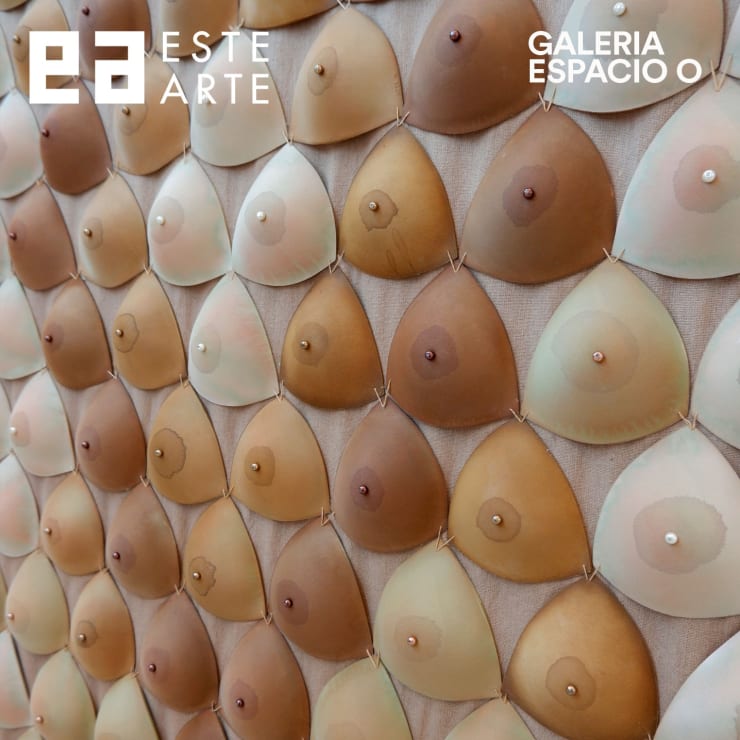
EsteArte
José Ignacio, Uruguay 6 - 10 Jan 2024Galería Espacio O participates for the first time in the tenth edition of the ESTE ARTE fair in José Ignacio, Uruguay. On a human scale,...Read more -

Ch.ACO '12
Santiago, Chile 22 - 28 Nov 2021La 12ºedición de la feria Ch.ACO contó este año con diferentes secciones de formato presencial y virtual, bajo el lema Sin Límites SECCIÓN MAIN: Sección...Read more










